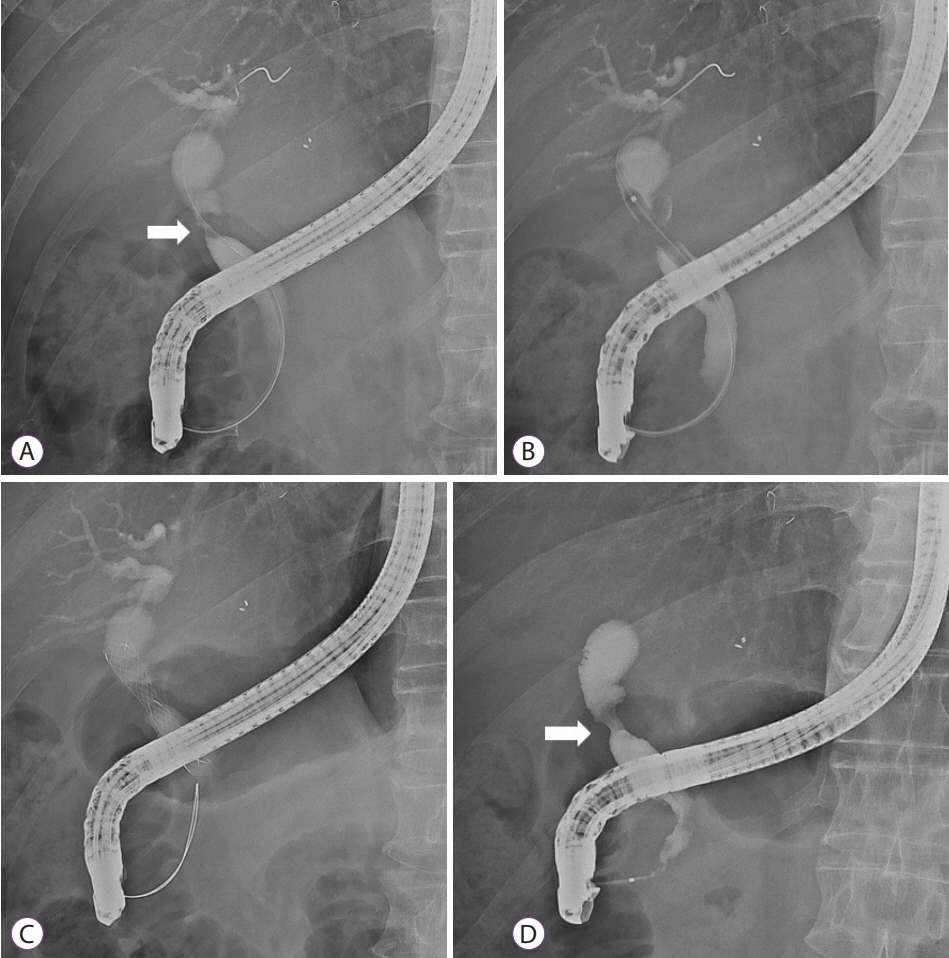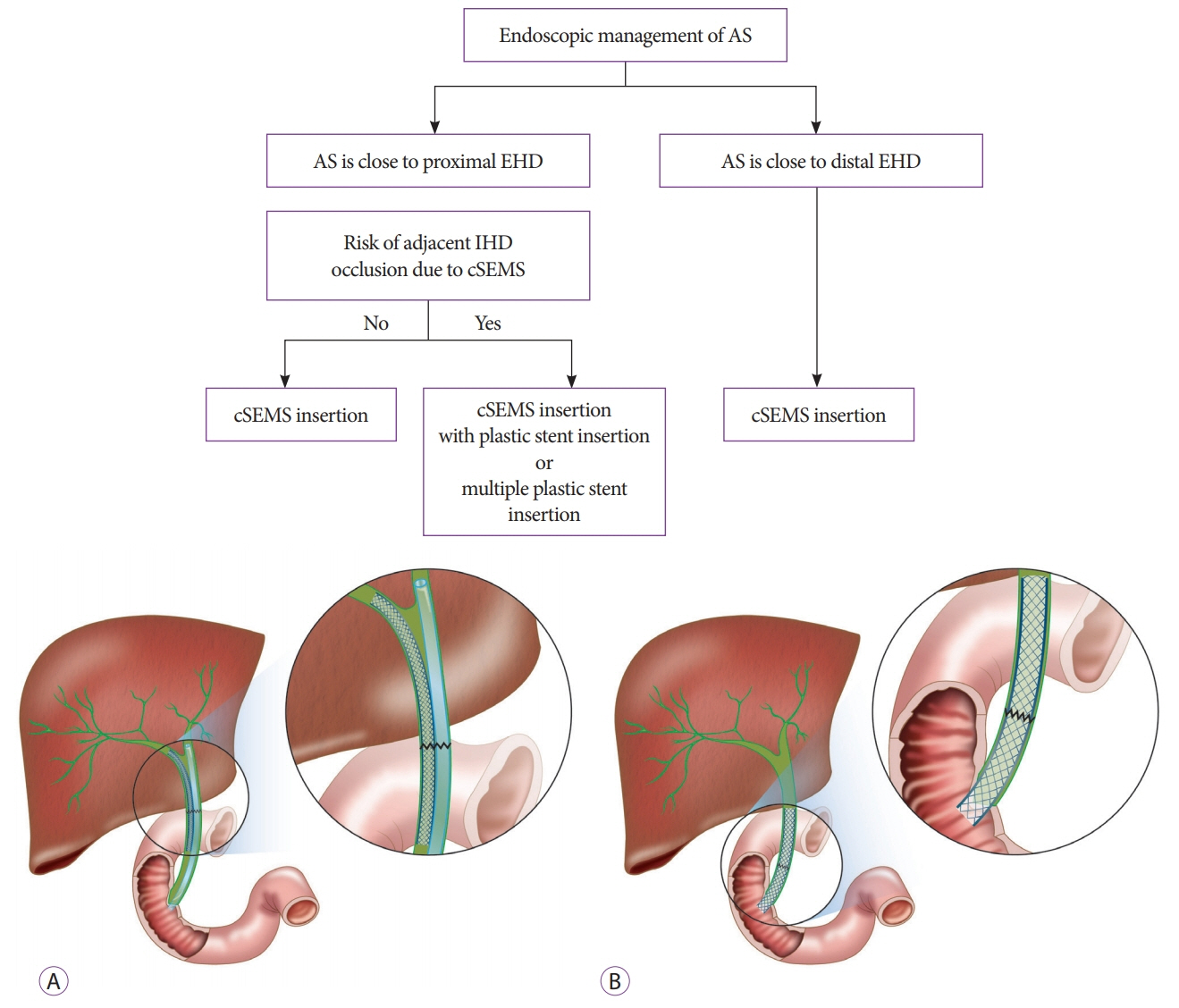Clin Endosc.
2020 May;53(3):261-265. 10.5946/ce.2020.119.
Management of Post-Transplant Anastomotic Stricture Using Self-Expandable Metal Stent
- Affiliations
-
- 1Division of Gastroenterology, Department of Internal Medicine, Daegu Catholic University School of Medicine, Daegu, Korea
- 2Division of Gastroenterology, Department of Internal medicine, Aichi Cancer Center, Nagoya, Japan
- KMID: 2502760
- DOI: http://doi.org/10.5946/ce.2020.119
Abstract
- Anastomotic stricture (AS) is one of the complications of liver transplantation (LT) and can occur in up to 40% of living-donor LTs. Endoscopic management has become the first-line treatment of AS, and multiple plastic stents insertion has been mainly used in the past. Recently, many treatments utilizing fully covered self-expandable metal stents (cSEMSs) have been attempted, and results showing adequate treatment outcome have been reported. In this review, we look into the treatment performance and cautionary steps needed when using cSEMS as a treatment for AS.
Figure
Reference
-
1. Murray KF, Carithers RL Jr. AASLD practice guidelines: evaluation of the patient for liver transplantation. Hepatology. 2005; 41:1407–1432.
Article2. Durand F, Levitsky J, Cauchy F, Gilgenkrantz H, Soubrane O, Francoz C. Age and liver transplantation. J Hepatol. 2019; 70:745–758.
Article3. Stepanova M, Wai H, Saab S, Mishra A, Venkatesan C, Younossi ZM. The portrait of an adult liver transplant recipient in the United States from 1987 to 2013. JAMA Intern Med. 2014; 174:1407–1409.
Article4. Martins FP, De Paulo GA, Contini MLC, Ferrari AP. Metal versus plastic stents for anastomotic biliary strictures after liver transplantation: a randomized controlled trial. Gastrointest Endosc. 2018; 87:131. e1-e131.e13.
Article5. ASGE Technology Assessment Committee, Pfau PR, Pleskow DK, et al. Pancreatic and biliary stents. Gastrointest Endosc. 2013; 77:319–327.
Article6. Chaput U, Scatton O, Bichard P, et al. Temporary placement of partially covered self-expandable metal stents for anastomotic biliary strictures after liver transplantation: a prospective, multicenter study. Gastrointest Endosc. 2010; 72:1167–1174.
Article7. Kaffes A, Griffin S, Vaughan R, et al. A randomized trial of a fully covered self-expandable metallic stent versus plastic stents in anastomotic biliary strictures after liver transplantation. Therap Adv Gastroenterol. 2014; 7:64–71.
Article8. Girotra M, Soota K, Klair JS, Dang SM, Aduli F. Endoscopic management of post-liver transplant biliary complications. World J Gastrointest Endosc. 2015; 7:446–459.
Article9. Verdonk RC, Buis CI, Porte RJ, Haagsma EB. Biliary complications after liver transplantation: a review. Scand J Gastroenterol Suppl. 2016; (243):89–101.
Article10. Pasha SF, Harrison ME, Das A, et al. Endoscopic treatment of anastomotic biliary strictures after deceased donor liver transplantation: outcomes after maximal stent therapy. Gastrointest Endosc. 2007; 66:44–51.
Article11. Akhter A, Pfau P, Benson M, Soni A, Gopal D. Endoscopic management of biliary strictures post-liver transplantation. World J Metaanal. 2019; 7:120–128.
Article12. Facciorusso A, Rosca EC, Ashimi A, et al. Management of anastomotic biliary stricture after liver transplantation: metal versus plastic stent. Ann Gastroenterol. 2018; 31:728–734.
Article13. Visconti TAC, Bernardo WM, Moura DTH, et al. Metallic vs plastic stents to treat biliary stricture after liver transplantation: a systematic review and meta-analysis based on randomized trials. Endosc Int Open. 2018; 6:E914–E923.
Article14. Lee DW, Han J. Endoscopic management of anastomotic stricture after living-donor liver transplantation. Korean J Intern Med. 2019; 34:261–268.
Article15. Rao HB, Prakash A, Sudhindran S, Venu RP. Biliary strictures complicating living donor liver transplantation: Problems, novel insights and solutions. World J Gastroenterol. 2018; 24:2061–2072.
Article16. Cui PJ, Yao J, Zhao YJ, Han HZ, Yang J. Biliary stenting with or without sphincterotomy for malignant biliary obstruction: a meta-analysis. World J Gastroenterol. 2014; 20:14033–14039.
Article17. Devière J, Nageshwar Reddy D, Püspök A, et al. Successful management of benign biliary strictures with fully covered self-expanding metal stents. Gastroenterology. 2014; 147:385–395. quiz e15.
Article18. Tsujino T, Sugawara Y, Omata M. Management of biliary strictures after living donor liver transplantation. Gastrointest Endosc. 2009; 70:599–600. author reply 600-601.
Article19. Tal AO, Finkelmeier F, Filmann N, et al. Multiple plastic stents versus covered metal stent for treatment of anastomotic biliary strictures after liver transplantation: a prospective, randomized, multicenter trial. Gastrointest Endosc. 2017; 86:1038–1045.20. Poley JW, Cahen DL, Metselaar HJ, et al. A prospective group sequential study evaluating a new type of fully covered self-expandable metal stent for the treatment of benign biliary strictures (with video). Gastrointest Endosc. 2012; 75:783–789.
Article21. Tarantino I, Traina M, Mocciaro F, et al. Fully covered metallic stents in biliary stenosis after orthotopic liver transplantation. Endoscopy. 2012; 44:246–250.
Article22. Sauer P, Chahoud F, Gotthardt D, et al. Temporary placement of fully covered self-expandable metal stents in biliary complications after liver transplantation. Endoscopy. 2012; 44:536–538.
Article23. Coté GA, Slivka A, Tarnasky P, et al. Effect of covered metallic stents compared with plastic stents on benign biliary stricture resolution: a randomized clinical trial. JAMA. 2016; 315:1250–1257.24. Lee DW, Jo HH, Abdullah J, Kahaleh M. Endoscopic management of anastomotic strictures after liver transplantation. Clin Endosc. 2016; 49:457–461.
Article
- Full Text Links
- Actions
-
Cited
- CITED
-
- Close
- Share
- Similar articles
-
- A case with combined postoperative bile leakage and anastomotic stricture after liver transplantation treated with magnet compression anastomosis
- Endoscopic Management of Anastomotic Strictures after Liver Transplantation
- Fracture of Self-Expandable Metal Stent during Endoscopic Removal in Benign Biliary Stricture
- Treatment of Transplant Renal Artery Stenosis with Expandable Metal Stent
- Stent Flange-Induced Esophageal Stricture Treated with an Oral Steroid



